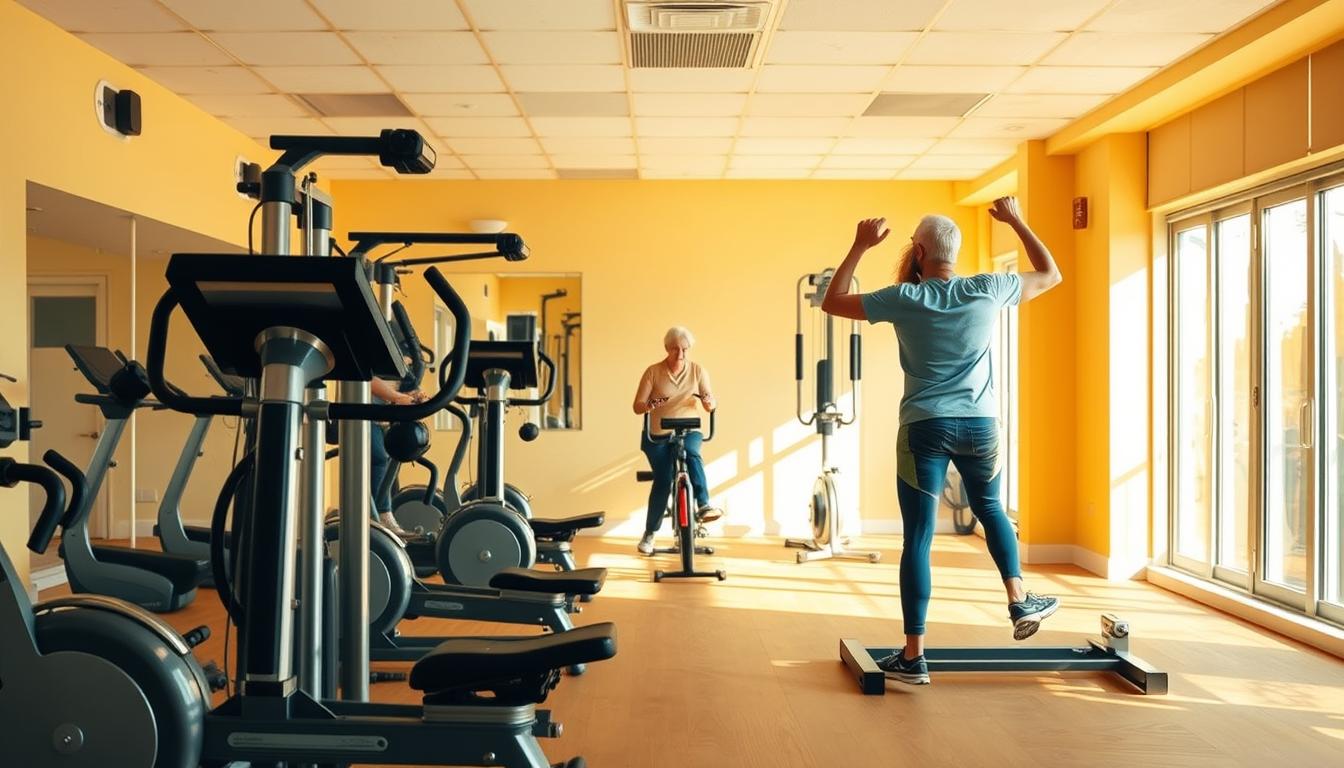Did you know that 30-40 minutes of exercise, 3-5 times a week, can help with anxiety, depression, and stress for those with arthritis? A 2023 study found that arthritis strength training is a big help. It makes managing joint pain and inflammation easier. Plus, it boosts your mood with anti-inflammatory workouts.
But, it's important to start slow and steady. Going too hard too soon can make joint pain worse. That's why mobility-enhancing exercises and injury prevention training are key. They help you build muscle safely, protecting your joints and supporting your health.
Benefits of Exercise for Arthritis
If you have arthritis, being active can change your life. Exercise helps manage your condition and boosts your health. It reduces pain, strengthens muscles, and improves your mood.
Reduced Pain, Fatigue, and Inflammation
Exercise is great for arthritis because it eases pain and swelling. Activities like walking, swimming, and strength training help. They make joints feel better and reduce inflammation.
Strengthened Muscles, Joints, and Bones with Arthritis Strength Training
Doing joint strengthening exercises is key for arthritis patients. Stronger muscles support joints, reducing pain. Weight-bearing exercises also keep bones strong, preventing osteoporosis.
Improved Heart Health and Diabetes Management
Exercise is good for your heart and diabetes. It lowers heart disease risk and manages blood pressure and cholesterol. It also helps control blood sugar levels.
Enhanced Mood, Balance, and Sleep Quality
Exercise does more than just improve physical health. It boosts mood and reduces depression and anxiety. It also improves balance and sleep, essential for arthritis management.
Adding exercise to your arthritis care plan can greatly improve your life. Talk to your doctor to create a workout plan that fits you.
Getting Started with Arthritis-Friendly Exercise
Starting an exercise program with arthritis should be done slowly. Aim for small increases in how hard or long you exercise. Many worry about exercising with arthritis, but not exercising at all is worse. It can make stiffness, pain, and injury worse.
Physical therapy experts say to start with low-impact exercises. Walking in waist-deep water cuts down joint weight by 50% and water aerobics by 75%. Cycling, both indoor and outdoor, is also good. It works your lower body, including your feet.
As you get stronger, you can try harder exercises. Walking can help ease arthritis pain and strengthen muscles. Cross-country skiing is a full-body workout with less knee twisting. Elliptical machines are easy on your lower body because of their circular motion.
It's wise to talk to a physical therapist or doctor before starting arthritis strength training. They can help pick safe and effective exercises for you. With the right help and a slow start, you can manage your arthritis through exercise.
| Exercise | Impact Reduction | Benefits |
|---|---|---|
| Walking in waist-deep water | 50% reduced weight on joints | Low-impact, strengthens muscles |
| Water aerobics | 75% reduced impact on joints | Low-impact, improves cardiovascular health |
| Indoor or outdoor cycling | N/A | Works all lower body muscles, including feet |
"The real concern is not exercising at all, which can lead to increased stiffness, pain, and injury."
Cardio Exercises for Arthritis Strength Training
Keeping active is key for managing arthritis. Strength training is important, but arthritis-friendly cardio exercises offer great benefits too. Walking is a low-impact option that's good for your heart and joints.
Walking can be outdoors or on a treadmill with arthritis. It helps improve your endurance and overall health. This simple exercise is very effective.
If you want a more challenging workout, try high-intensity interval training (HIIT). It involves short, intense activities followed by rest. HIIT boosts your fitness, burns calories, and helps move your joints better.
But, be careful not to do too much if it hurts. Listen to your body and avoid exercises that cause pain or swelling.

Finding the right mix of exercises is important for managing arthritis. Include arthritis-friendly cardio exercises in your routine. This way, you can stay healthy, reduce pain, and keep active.
Arthritis Strength Training
If you have arthritis, adding resistance training to your workout is key. Arthritis strength training helps build muscle strength and supports your joints. This can reduce strain and improve your balance and mobility. But, it's vital to do it carefully and with expert advice.
Physical therapist Marvin Smith says strength training is great for those with rheumatoid arthritis (RA). Eric Robertson, PT, also stresses the need for realistic goals. Start with light weights and more reps, then increase as you get stronger.
| Exercise | Recommended Weight |
|---|---|
| Arms and Upper Body | 5% to 10% of body weight |
| Legs | 25% of body weight |
Beginners with arthritis should aim to work out once every 4 days, says Smith. Or three times a week, Robertson suggests. Using resistance bands and body weight exercises at home can be effective. Make sure to rest for 20 to 30 minutes between workouts.
Studies show that people with arthritis can safely do resistance training. It can prevent and even reverse muscle weakness. Strength training increases muscle strength, endurance, and size, supporting your joints and reducing strain. It's recommended to do it regularly, under professional supervision.

When starting strength training, get help from a qualified health or exercise professional. They can guide you through pre-exercise screening, regular checks, and a tailored program. Look for arthritis offices in your area for information on suitable classes and professionals.
Incorporating Mobility and Balance Exercises
Managing arthritis is a big job, and adding mobility and balance exercises is key. Doing arthritis strength training range-of-motion exercises keeps your joints strong and flexible. Balance training and flexibility routines also boost joint health.
Low-impact activities like yoga, Tai chi, and Pilates are perfect for those with arthritis. These activities focus on slow, controlled movements. This helps improve mobility, stability, and balance. For instance, Tai Ji Quan: Moving for Better Balance program helps participants get better balance and lower fall risk.
Aquatic exercises are also great for arthritis, as water supports the body and eases joint pressure. The Arthritis Foundation Aquatic Program classes meet two to three times a week for one hour. They run for six to 10 weeks, making it a safe and effective way to boost mobility and strength.
| Exercise Program | Frequency | Duration |
|---|---|---|
| Arthritis Foundation Aquatic Program | 2-3 times per week | 1 hour, 6-10 weeks |
| Arthritis Foundation Exercise Program | 2-3 times per week | 1 hour |
| Active Living Everyday | Once a week | 12-20 weeks |
| Enhance®Fitness | 3 times per week | 1 hour |
| Fit & Strong! | 3 times per week | 90 minutes, 8 weeks |
| Tai Ji Quan: Moving for Better Balance | 2 times per week | 1 hour, 24 weeks |
Adding different arthritis mobility exercises, balance training, and flexibility routines to your routine can greatly help. It can improve joint health, reduce pain and inflammation, and enhance your life quality.
Conclusion for Arthritis Strength Training
Exercise is key for managing arthritis. A good plan includes cardio, strength training, and exercises for mobility and balance. These help reduce pain, strengthen muscles, and improve mood and sleep.
Start slow and work with healthcare experts to create a safe routine. This is true whether you're new to exercise or keeping up a routine. Regular activity brings many benefits.
Osteoarthritis is becoming more common, so taking care of your joints is crucial. A mix of cardio, strength, and flexibility exercises is essential. This approach helps manage symptoms and improves your life quality.
FAQ for Arthritis Strength Training
What are the benefits of exercise for people with arthritis?
How should individuals with arthritis start an exercise program?
What are some effective cardio exercises for people with arthritis?
Why is strength training important for individuals with arthritis?
What other types of exercises are beneficial for individuals with arthritis?
Source Links for Arthritis Strength Training
- https://www.arthritis.org/health-wellness/healthy-living/physical-activity/getting-started/exercise-and-strength-training-with-arthritis
- https://www.arthritis.org/health-wellness/healthy-living/physical-activity/getting-started/weight-training-101
- https://www.mayoclinic.org/diseases-conditions/arthritis/in-depth/arthritis/art-20047971
- https://www.hopkinsarthritis.org/patient-corner/disease-management/role-of-exercise-in-arthritis-management/
- https://www.ncbi.nlm.nih.gov/pmc/articles/PMC3606891/
- https://www.arthritis.org/health-wellness/healthy-living/physical-activity/other-activities/14-ways-to-work-out-with-arthritis
- https://creakyjoints.org/living-with-arthritis/exercise/exercising-with-arthritis-tips/
- https://www.cdc.gov/arthritis/prevention/index.html
- https://www.arthritis.org/health-wellness/healthy-living/physical-activity/other-activities/best-exercises-for-rheumatoid-arthritis
- https://www.webmd.com/arthritis/exercise-treat-arthritis
- https://www.arthritisresearch.ca/30-day-exercise-challenge-for-arthritis/
- https://www.webmd.com/rheumatoid-arthritis/features/strength-exercises-for-ra
- https://arthritisaustralia.com.au/managing-arthritis/living-with-arthritis/physical-activity-and-exercise/strength-training/
- https://www.arthritis.org/health-wellness/healthy-living/physical-activity/getting-started/physical-activity-programs-proven-to-help-arthriti
- https://advancedorthosports.com/blog/exercises-for-arthritis-pain-management-a-comprehensive-guide-from-an-expert-pain-management-doctor/
- https://www.ncbi.nlm.nih.gov/pmc/articles/PMC10379804/
- https://www.rheumatologyadvisor.com/news/strength-training-supports-knee-health-reduces-likelihood-of-knee-osteoarthritis-pain/

[…] strengthening exercises to your arthritis walking program can greatly improve joint health. The Heel and Toe Raises are a […]
[…] Strength training with light weights or resistance bands […]
[…] Strengthening muscles around painful joints is a good strategy. Straight leg raises can support joints and ease discomfort2. Orthopedic surgeon Geoffrey Westrich advises getting up every half hour to walk for at least five minutes. This helps prevent stiff joints and back pain from sitting2. […]
[…] Strength training is key for those with arthritis. It helps build strong muscles. These muscles support and protect your joints, easing pain and stiffness. […]